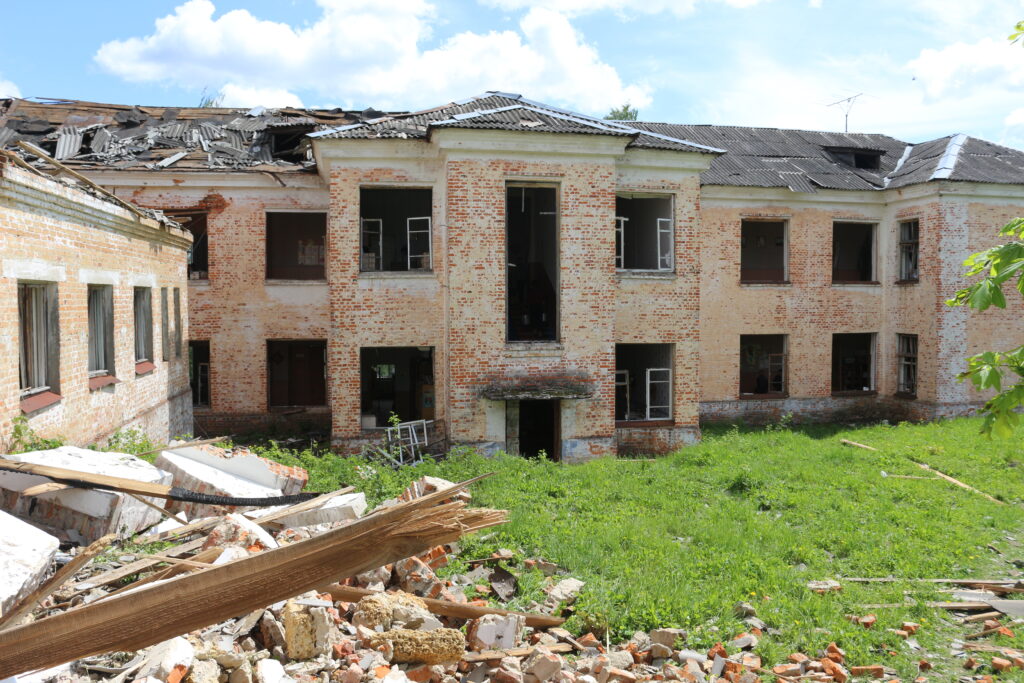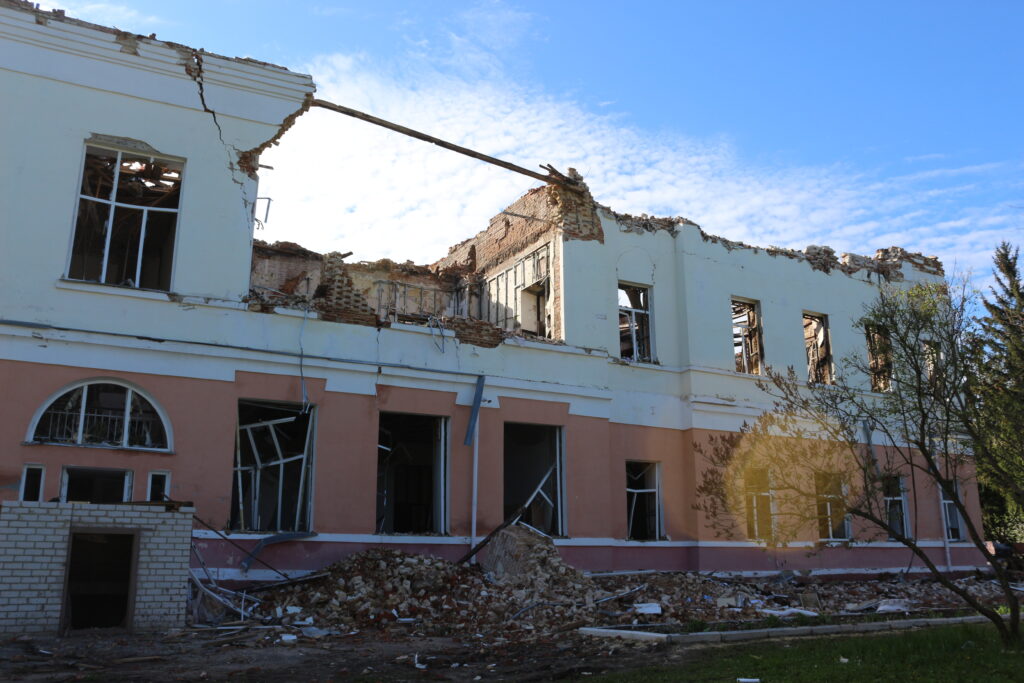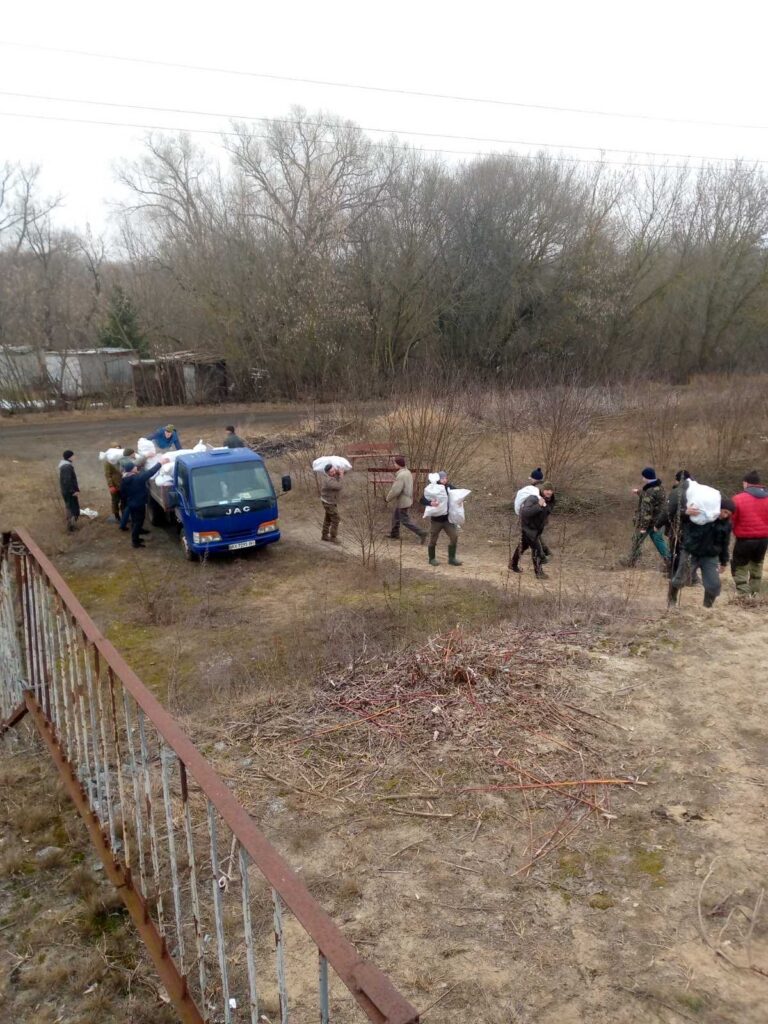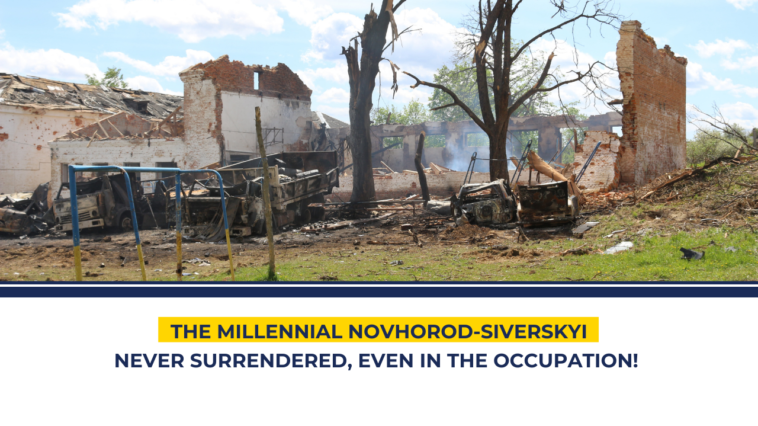Novhorod-Siverska city territorial community is located in the north of the Chernihiv region. The centre of the community – Novhorod-Siverskyi – is a picturesque corner located on the Desna River and one of the oldest cities in Ukraine. Its thousand-year history is connected with Prince Ihor Sviatoslavych, the hero of The Tale of Ihor’s Campaign. Old East Slavic, Cossack, Polish and Russian histories are intertwined here. And this same community was one of the first to feel the consequences of “protecting and rescuing people from the Kyiv regime” by Russia, which invaded Ukraine on February 24. The head of the Novhorod-Siverska community, Liudmyla Tkachenko, and her team have been under occupation since the first days of the war. And even after the liberation, the Russians do not leave this community alone. On May 12, 2022, Russian airstrikes killed three people, wounded 30, and destroyed two schools. We talked to Liudmyla about the occupation, the courage and bravery of the Novhorod-Siverskyi citizens, recalled how the community lived until February 24 and also made plans for the future.
How did you find out about the beginning of a full-scale Russian invasion? What were you thinking at the time?
On February 24, around 5 a.m., I received a phone call. My first deputy called and said that the war had begun. At first I did not accept this information. How’s the war? And then calls from border settlements have already begun, ‘My dear, what should we do? This is what is happening here, thousands of units of equipment are going here!’ On the first day, Russian troops shelled our villages of Hremiach and Buchky.
Where was your family?
It has been with me since the first days of the war. Actually, I didn’t even think of going anywhere. However, I wanted to send my son, a student at a university in Kyiv, to relatives in the Ivano-Frankivsk region. But he told me, ‘I’m not a traitor, I will not leave you here, I will be with you to the end!’ I was so motherly proud that I raised my son that way.
Were you born in the Chernihiv region?
I was born in Mariiampil, Ivano-Frankivsk region. My mother is from the west of Ukraine. The paternal family line, which is over 300 years old, is associated with the Novhorod-Siverskyi area. And when the teacher at school told us about the famous ancient literary monument The Tale of Ihor’s Campaign, she noticed how closely intertwined different parts of our country are. Yaroslavna, as we know, was from Halych, and Prince Ihor – from Novhorod-Siverskyi. And I thought to myself then: my mother is also from Halych, and my father is from Novhorod-Siverskyi. And there was something so mystical about it. I never thought that I would live in Novhorod (as the locals call Novhorod-Siverskyi) and even become the head of the community because my childhood and youth were spent in the west of Ukraine. I graduated from the Ternopil University and then moved to Novhorod-Siverskyi because my father returned to his small homeland. Here I got married and settled down.
You said you never thought you would be the head of the community…
I worked at the Customs, in the Tax Service, and later in the Social Insurance Fund. And when Oleh Bondarenko, who headed the Social Insurance Fund, won the election and became mayor, he invited me to his team. He won the election again in October 2020 but unfortunately died of coronavirus on the third day after the announcement of the results. In January 2021, new elections were held and among 8 candidates, people entrusted the position of mayor to me. And then together with the team, we created the Novhorod-Siverska city community, which includes 83 settlements.
Your community has been under occupation since the first days of the war. What was going on in the community at that time?We were cut off from the world. But we never gave up because we knew we were the northern outpost of the country. From the first days of the invasion, Novhorod-Siverskyi was under siege. Russian troops blocked the entrances and exits of the city with tanks. They drove through the streets and, by the way, were stationed near the place where my family and I lived. The Russian military initially thought they would be greeted with bread and salt. And they were non-aggressive. Citizens came to them and asked what they were doing in Ukraine. They said that they had come to save Ukrainians from the Nazis. To which people replied, ‘And where did you see the Nazis here? We don’t need to be saved!’ At checkpoints, Russians took phones from locals and smashed them. They prevented the ambulance from passing. Doctors went to the boy, who was in serious condition. Russian servicemen tortured, shot, and intimidated paramedics.

Were there any threats from the occupiers to you?
I was told by locals that the Russian military was asking people about their authorities. I received threatening phone calls from them. They told me ‘See you soon, pussycat!’ and called me ‘a b**ch in an embroidered shirt’. We were even psychologically ready for the fact that at any moment they could break into the city council. Of course, it was scary because we didn’t know what to do. There were no weapons, we are civilians. At that time, our territorial defense was defending Chernihiv. The first thing we did was destroy the documents related to the anti-terrorist operation participants. In those terrible days, I convened local activists. I was surprised because so many men came and they all didn’t fit in the assembly hall. The guys told me, ‘Liudmyla Mykolaivna, we are with you, we will not surrender the city!’. Around-the-clock patrol in all settlements was immediately organized. I understood how united our Ukrainian people are, and in times of trouble, they are ready for such actions that in peacetime we could not even imagine.
Heads of communities remain at risk today. Were there any instructions from the authorities on how to act in the occupation?
We discussed this with the heads of the communities. There were no clear instructions on what to do. You see, on the one hand, we and our relatives were in danger, and on the other hand, if you evacuate, you will be accused of treason. Honestly, everyone did it according to their conscience. And my colleagues did not leave the community. From the first to the last day they were in place. My team worked the same way and they were also in danger. We did what we thought was right. In my opinion, at the legislative level, it was necessary to prescribe steps, and what to do when you are under occupation. After all, community leaders were abducted, shot, and accused of treason. We were at risk and unprotected. I was morally supported by the head of the Chernihiv Military Administration, Viacheslav Chaus, and this is very important when you are left alone with the war, with all the problems. My deputies say I’m an iron lady. I was supported by my family and my team. I showed them an example of how not to give up and our team worked in coordination.
All of Ukraine was worried about the fate of the head of the village of Hremiach in your community, who was abducted and taken to Russia. How did the Russian military behave in the rural settlements of the community?
The rural settlements of Hremiach and Mykhalchyna Sloboda have suffered the most. At first, there was no aggression. But when the Russian military saw that they were not welcome here, they began to break into villages and look for border guards, anti-terrorist operation participants, and weapons. They demanded fuel and food. I want to say that our people are proud, they just do not give up easily. Russian soldiers began kidnapping, abducting, and torturing people. So the starosta of Hremiach was taken out. She was put in an armoured personnel carrier and abducted so she won’t interfere. The woman was held captive for 19 days, returned in critical condition, and has not yet been rehabilitated. She was accused of being a spotter. She is 62 years old and, imagine, she was shaved, interrogated 4 times a day, psychologically and physically abused.
We managed to warn the head of the village of Mykhalchyna Sloboda in time, and she was able to hide. She hid with small children until she became safe. Unfortunately, Russian soldiers kidnapped an 18-year-old boy from Hremiach to Russia. They took him out only because they found a T-shirt with a trident in his house. The medical college student received this T-shirt for participating in the Dzhura patriotic game. And the child was beaten for this T-shirt because they considered him a ‘Nazi’. Fortunately, the boy returned home. Unfortunately, one family from Hremiach disappeared. First, the husband was taken away, then the wife disappeared. We don’t even know where the family is now.

What was the hardest thing to go through?
I remember March 9th. The first 5 buses from Chernihiv arrived in Novhorod-Siverskyi. There was only one road where people could get to the crossing. But for this, they had to run 8 kilometers across the field under attack by the occupiers. Volunteers then picked up these people and transported them by boat. And when five buses arrived in Novhorod-Siverskyi, it was such a joy! We were glad that no one was hurt, that we saved these people. But on the evening of March 9, the head of Menska community called me and told me about the death of the boy who had been shot while trying to return home from Chernihiv to Novhorod-Siverskyi. He did not arrive… The chairman called the name of this child and I had a nervous breakdown. It was the only time I allowed myself to worry. I knew this boy from an early age, he went to school with my son. My heart stopped. It is very difficult to gather yourself in a fist and inform parents. It was the hardest part. For a long time, I could not call the mother of this boy and say about the death of the child. It’s hard to remember.
Unfortunately, we have buried more than one soldier in our community. The last boy was 30 years old, the only son of his parents. He died in the Donbas. We promised the mother that we would bring our son home. We brought… What this war has done…
How did the community survive the siege? How were problems with food, medicine, and fuel solved?
During the siege we did not give up, we tried to find a way out, even though there was a danger. We tried to support people, just as people supported us. The only way we called the ‘road of life’ was the guerrilla path, it allowed us to somehow supply food, baby food, and medicine to the community. It was the neighbouring Sumy region, the city of Shostka – wholesale bases remained intact there.
We tried in different ways to survive and show the Russians that we are not afraid. There was also the fact that under fire we had to get to the Poltava region because only there we could get fuel. Our starostas got behind the wheel of fuel trucks because the drivers refused. And they are real heroes, because they travelled under fire and on bypass roads through the Sumy region, where active hostilities took place. In addition, our guys equipped a draisine and brought bread from Shostka. Novhorod-Siverskyi never gave up, and our men proved once again that they are ready to defend not only the city and the community but the whole of Ukraine.

Today, memorials and names of the former Russian Empire and the Soviet Union are being removed in different parts of Ukraine. Is there anything to rename in your community?
On April 7, portraits of Lenin and Stalin were dismantled from the water tower in Novhorod-Siverskyi. This was the first step. We have also already removed the images of the Orders of Lenin and the Red Star, which were placed in a store in the city centre. The other day a commission to deal with street renaming in the community was established. We do not want to have anything to do with either the imperial or the Soviet past.
When the war is over, what will you start rebuilding first?
We will start with the reconstruction of our educational institutions, which were destroyed by Russian troops on May 12. We will repair city roads. I want to return to the project of the central square of the city, complete the reconstruction of the embankment, and build fountains. In the year before the war, we managed to do a lot in cooperation with international organisations, so we plan to continue to build our community.
Author: Oksana Yakunina



